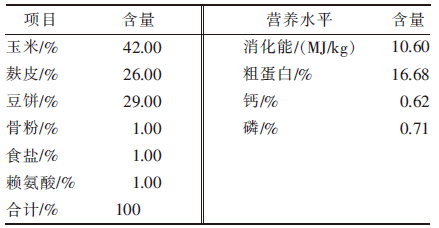| [1] |
MERUELO D, LAVIE G, LAVIE D. Therapeutic agents with dramatic antiretroviral activity and little toxicity at effective doses:Aromatic polycyclic diones hypericin and pseudohypericin[J]. Proceedings of the National Academy of Sciences, 1988, 85(14):5230-5234.
doi: 10.1073/pnas.85.14.5230
|
| [2] |
王怀冲, 范国荣, 何莉. 贯叶连翘提取物中金丝桃苷的HPLC测定[J]. 中国医药工业杂志, 2006, 37(2):119-120.
|
| [3] |
KITANOV G M. Hypericin and pseudohypericin in some Hypericum species[J]. Biochemical Systematics and Ecology, 2001, 29(2):171-178.
doi: 10.1016/S0305-1978(00)00032-6
|
| [4] |
杨华明, 武斌, 闫晓刚, 等. 莫能菌素和吐温80对肉羊氮沉积及甲烷排放量的影响[J]. 中国畜牧兽医文摘, 2016, 32(8):54-56.
|
| [5] |
孟岩, 蔡鹏, 何玉华. 吉林左家地区刺老芽对肉鸡生长性能及免疫器官发育的影响[J]. 中国兽医杂志, 2017, 53(3):61-63.
|
| [6] |
唐中海, 游章强, 刘昊, 等. 饲粮添加油橄榄叶对育肥期獭兔生长、血液生化指标及抗氧化能力的影响[J]. 中国农业科学, 2013, 46(5):1081-1086.
doi: 10.3864/j.issn.0578-1752.2013.05.024
|
| [7] |
吴艳玲. 日粮不同锰水平对雏鸭生长性能的影响[J]. 黑龙江畜牧兽医, 2019(12):58-59.
|
| [8] |
付云超, 薛琳琳, 邓绍录. 复合菌制剂对断奶仔猪生产性能的影响[J]. 黑龙江畜牧兽医, 2016(16):184-185.
|
| [9] |
何玉华. 马铃薯糖苷生物碱对小鼠肠道功能的影响及机理研究[D]. 长春: 吉林农业大学, 2017.
|
| [10] |
张梅梅. 黄酮类化合物抗氧化能力的比较及其对肠道菌群的调节作用[D]. 重庆: 西南大学, 2018.
|
| [11] |
张丹丹. OsDCL1基因沉默增强水稻对稻瘟菌的基础抗性机理[D]. 杭州: 浙江大学, 2015.
|
| [12] |
张克勤, 蒋丽, 张俊杰, 等. 金丝桃素抗鸡球虫效果观察[J]. 湖北农业科学, 2012, 51(19):4316-4320.
|
| [13] |
何绍港, 张启月, 马明阳, 等. 乌腺金丝桃对小鼠生长性能及器官发育的影响[J]. 中国饲料, 2021(1):36-38.
|
| [14] |
吴鑫宇, 高彦宇, 朱洁宜, 等. 乌腺金丝桃对类风湿关节炎大鼠NO及VEGF表达的影响[J]. 中医药信息, 2016, 33(4):4-6.
|
| [15] |
李冀, 隋姝婷, 胡晓阳, 等. 乌腺金丝桃与当归配伍对MIRI大鼠的保护作用研究[J]. 中医药信息, 2016, 33(1):12-14.
|
| [16] |
高彦宇, 李冀, 滕林. 乌腺金丝桃提取物对大鼠离体心脏左心室功能的影响[J]. 中医药信息, 2009, 26(4):84-86.
|
| [17] |
李冀, 滕林, 高彦宇. 乌腺金丝桃提取物对小鼠心肌缺血的保护作用[J]. 中国中医药信息杂志, 2009, 16(1):38-39.
|
| [18] |
LIANG C, LI Y, BAI M, et al. Hypericin attenuates nonalcoholic fatty liver disease and abnormal lipid metabolism via the PKA-mediated AMPK signaling pathway in vitro and in vivo[J]. Pharmacological Research, 2020, 153(9):104657.
doi: 10.1016/j.phrs.2020.104657
|
| [19] |
YACHIDA S, MIZUTANI S, SHIROMA H, et al. Metagenomic and metabolomic analyses reveal distinct stage-specific phenotypes of the gut microbiota in colorectal cancer[J]. Nature Medicine, 2019, 25(6):968-976.
doi: 10.1038/s41591-019-0458-7
pmid: 31171880
|
| [20] |
WANG K, LIAO M F, ZHOU N, et al. Parabacteroides distasonis alleviates obesity and metabolic dysfunctions via production of succinate and secondary bile acids[J]. Cell Reports, 2019, 26(1):222-235.
doi: 10.1016/j.celrep.2018.12.028
|
| [21] |
OLSON C A, VUONG H E, YANO J M, et al. The gut microbiota mediates the anti-seizure effects of the ketogenic diet[J]. Cell, 2018, 173(7):1728-1741.
doi: S0092-8674(18)30520-8
pmid: 29804833
|
| [22] |
JIN D X, HE J F, LUO X G, et al. Hypoglycemic effect of Hypericum attenuatum Choisy extracts on type 2 diabetes by regulating glucolipid metabolism and modulating gut microbiota[J]. Journal of Functional Foods, 2019, 52:479-491.
doi: 10.1016/j.jff.2018.11.031
|
| [23] |
吕明, 李星雨, 叶方, 等. 乌腺金丝桃药理作用研究进展[J]. 药物评价研究, 2019, 42(10):2119-2124.
|
| [24] |
FEYZIOGLU B, DEMIRCILI M E, OZDEMIR M, et al. Antibacterial effect of hypericin[J]. African Journal of Microbiology Research, 2013, 7(11):979-982.
|
| [25] |
SYTAR O, ŠVEDIENE J, LOŽIENE K, et al. Antifungal properties of hypericin, hypericin tetrasulphonic acid and fagopyrin on pathogenic fungi and spoilage yeasts[J]. Pharmaceutical Biology, 2016, 54(12):3121-3125.
doi: 10.1080/13880209.2016.1211716
|
| [26] |
ZHANG J N, ZHANG F, TANG Q J, et al. Effect of photodynamic inactivation of Escherichia coli by hypericin[J]. World Journal of Microbiology and Biotechnology, 2018, 34(7):100.
doi: 10.1007/s11274-018-2464-1
|






